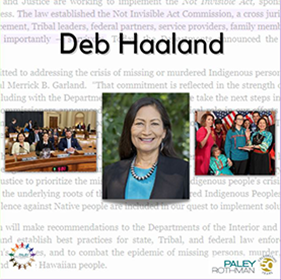Sec. Deb Haaland – First Native American in the Cabinet

Secretary of the U.S. Department of the Interior Deb Haaland is currently making history as the first Native American to serve in a President’s cabinet.
A member of the Pueblo of Laguna, Sec. Haaland was born a 35th generation New Mexican to a military family (her father was in the Marines and her mother in the Navy). As a single mother, Haaland put herself through college and law school and started her own small business (producing and canning salsa).
Her political career began with her service as a tribal administrator at San Felipe Pueblo. From there she was elected to the Laguna Development Corporation Board of Directors which oversees tribal gaming. After an unsuccessful run for New Mexico Lieutenant Governor in 2014, she was elected to Chair the New Mexico Democratic Party – making her the first Native American woman elected to lead a state political party. In 2018, she was one of the first two Native American women elected to Congress and, on March 18, 2021, she became the first Native American in history to serve as a cabinet secretary assuming the position of Secretary of the Interior. The Department of the Interior includes the Bureau of Indian Affairs, meaning that, for the first time, a Native person is leading the agency that oversees the United States’ relationship with Native tribes. Throughout her political career, one of the key issues that Sec. Haaland has brought attention to is violence against Indigenous women. According to the Centers for Disease Control and Prevention, murder is the third leading cause of death for Indigenous women, and the murder rate for women living on reservations is ten times the national average. Native American and Native Alaskan women are also significantly more likely to go missing or experience sexual violence than non-native women in this country. The legal landscape has been a key factor contributing to these staggering figures. According to the Department of Justice, non-Native perpetrators are responsible for the majority of the violent crimes on Native lands. However, based on jurisdictional limitations, the tribal governments do not have the authority to prosecute crimes committed by non-Natives on tribal land and federal prosecutors have frequently declined to pursue these cases.
When she was in Congress, then Representative Haaland served as vice-chair of the House National Resources Committee. During her time in leadership, the Committee held its first ever hearings on the issue of missing and murdered indigenous women which led to the passage of the Not Invisible Act and the Savanna’s Act – both focused on addressing the crisis. Within a month of her swearing in, in April 2021, Sec. Haaland announced the formation of a special unit – the Missing & Murdered Unit – within the Bureau of Indian Affairs Office of Justice Services to coordinate the government’s work to address the epidemic of missing and murdered Indigenous people. While, with Sec. Haaland’s leadership, this issue has been getting more attention, the violence against Indigenous people, in particular women and girls, remains a critical and underreported issue in the United States.
We encourage you to learn more about this issue. Coalition to Stop Violence Against Native Women has collected a great deal of information and resources which are collected on their website - https://www.csvanw.org.
